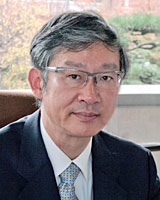The purpose of establishment of “Human Logistics & Tourism” Laboratory

After the Pacific War was over, Japanese more than 7 million came back to Japan from foreign countries and our economic social revival began from approximately 75 million people. When so-called baby boom generation reached coming-of-age ceremony, the population of Japan surpassed 100 million people. Many Japanese of those days grew with a future dream.
In Japanese economic society, the metropolis absorbed the population from rural areas and it appeared as a movement phenomenon of the space axis of population. The special train which picked up the youth who moved from rural areas to urban areas symbolized this phenomenon. Japanese economic society enjoyed the fruits of population bonus(Demographic Dividend). We are discussing the issue of low birth rate today. It was estimated that Japan’s population would reach about 100 million by 2050. The big change of the population judging from temporal axis happens in islands of Japan in this century. However, Japanese economic society where 100 million people live in is sure to be continuing after the baby boom generation disappeared. And economic social power of Japan must be a big thing.).
Development of information-communication and transport technology let human exercise activate and greatly changed a human life method. The era of depopulation begins. Population onus (opposite of population bonus) will influence us. It is important for not only Japanese economic society but also individual life to increase visitors. This recognition is becoming strong. It is necessary to use information-communication technology and transport technology, etc. for that. It is time when these technologies should be used for not only tourists in Japan but also tourists in Asian nations where remarkable growth is forecast. We have come at time when it should think about “system creation concerning human logistics” that can correspond to Google and Amazon who develop global new business model.
Artificial intelligence and brain science are accomplishing further progress. Now we must utilize big data collected through information-communication technology. For not only the industry but also human logistics & tourism studies researchers, the analysis based on data having low objectivity to investigate the simple subjective intention such as questionnaires is not permitted. In the business deployment, the time when it cannot help rushing into a new phase at a dash is approaching.
It is important that industrial person, consumer, researcher, journalist concerning human logistics & tourism can exchange opinions. And then they recognize new consumer needs that surround the human logistics & tourism industry and they will develop their economic society by creation of new solutions to answer the needs.
Therefore “Human Logistics and Tourism” Laboratory is established here.
The Head of “Human Logistics & Tourism” Laboratory
TERAMAE SHUICHI , Ph.D















